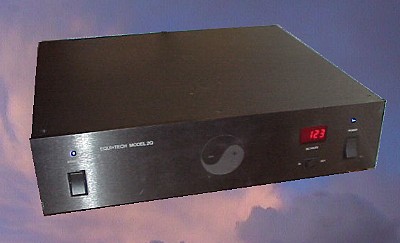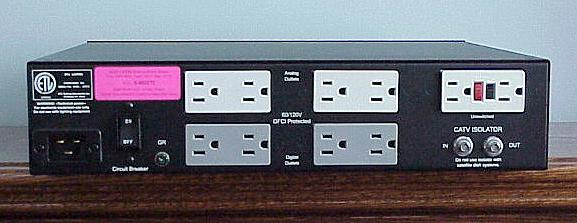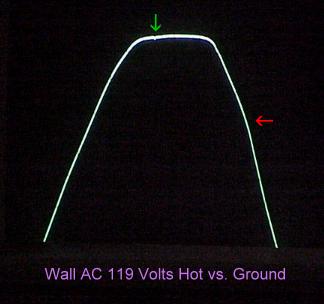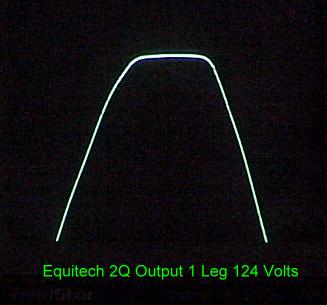 |
Model 2Q 10 Outlet Line Conditioner; Fully Balanced 120 Volt Output 20 Ampere Maximum Output Dimensions: 3 1/2" H x 16 1/2" W x 16" D Weight: 65 Pounds MSRP: $2,500 USA |
| Equi=Tech Corporation, P.O. Box 249, Selma, Oregon 97538; Phone 541-597-4448; Fax 541-597-4099; E-Mail [email protected]; Web http://www.equitech.com |
Introduction
Ever since we found measurable results using AC line conditioners at our first Annual Benchmark Event (held in 2000), my interest in trying various technologies has been kindled. One of the most promising is represented by fully balanced transformers. Such transformers have a primary winding to which the wall AC is connected, and a secondary (or several secondaries) winding with what is called a center tap. This tap is at the exact center of the secondary, and the output ground is connected to this. With wall AC, you might have 120 Volts total, but the hot vs. ground measures 120 Volts, while the neutral vs. ground measures 15 Volts. In other words, there is a ground potential. Such ground potentials cause ground loop hum. Also, the differences in the two main conductors vs. ground result in differing magnetic fields. Enter balanced AC. The hot vs. ground measures 60 Volts, and the neutral vs. ground measures 60 Volts, i.e., absolute balance. And, all three conductors, including ground, are isolated from other electrical items in your house. This eliminates ground loop hum, eliminates common mode RF noise, because they cancel out of the two conductors that both have 60 Volts (this is called common mode rejection, or CMR).
Equi=Tech's Technology
Equi=Tech has been making balanced transformers for a very long time. They supply them in sizes all the way up to 500,000 watts for industrial use. A couple of years ago, we reviewed the 1.5R. It produced quieter background (less noise) and a blacker video. The 1.5R is a 15 amp unit. Recently, Equi=Tech has developed what they call their Q transformers which are said to have the following advantages: (1) lower mechanical noise in response to poor wall AC; (2) larger mass so the core does not easily saturate, preventing in-rush current at turn-on, which might otherwise trip your house circuit breaker; and (3) faster current delivery during high demand transients.
The Equi=Tech 2Q is rated at 20 amperes maximum output, and it is supposed to be connected to a 20 amp line. Thus, the AC plug to the wall is IEC. Your wall socket probably is not IEC, and you will have to install one ($4). Here is what it looks like (photo below).

The rear panel of the 2Q has five socket pairs (see photo below). Two of them have further noise filters in the chassis for use with digital products like CD players, DVD players, DACs, etc. The fifth one (top right corner) is a GFI (Ground Fault Interrupt) socket which will trip if current in one leg of the output with respect to ground is higher than the other. This protects you in case of a shock hazard in one of your hi-fi components. There is also a CATV ground isolator, for those users who have ground loop problems in their cable TV wiring (which means just about everyone). To use this, you connect the TV cable from the wall to the input of the isolator and the output of the isolator to your TV or cable receiver box. This saves you $100 right off the bat (commercial ones are not cheap). There is also a grounding terminal on the rear panel, for grounding all of your hi-fi chassis if you wish. The AC cable is 20 amp, requiring the unusual prong configuration seen in the photo of the rear panel (lower left corner), so most high-end cables will not fit this. If you like certain brands of power cables, you will probably have to get one custom terminated. The supplied cable worked just fine though.

In order to turn the 2Q on, several rocker switches have to be activated, including the GFI. These are safety measures. Once turned on, the front panel will read a choice of wall socket voltage or the 2Q output voltage. I found that output was about 4 Volts above the input voltage, indicating that the turn ratio of secondary to primary must be about 1.03 to 1.00. This is presumably for bringing a typical 115 Volts up closer to the full 120 Volts. My problem came when I used it during the day, and the output voltage was around 124. This did not seem to give me any problems, but I see that it might shorten the life of some tubes.
I connected everything in our home theater system to the 2Q, including Yamaha DSP-A1 Receiver, Yamaha DVD Player, Cinepro 3k6 SE Gold (425 watts x 6, and I used 5 channels), six subwoofers, and a Sony LCD front projector. I had some trouble with the GFI tripping whenever I turned on the projector, so there may have been some ground current leakage in the Sony. I sent the review unit to John Kotches (see his comments below), and he did not experience any GFI tripping issues. Other than that, the 2Q worked without any problems at all.
And the sound . . .
Well, I have to say that my previous experiences with balanced AC in a high-performance audio system were confirmed in my home theater, using the 2Q. The amount of bass coming out of those six subwoofers did not change, but their character changed. It seemed cleaner and deeper, I suspect due to a lower output impedance of the 2Q vs. the wall AC. The wall socket is likely to have an impedance of about 0.5 Ohms, which is one part of the mathematics that are involved in voltage drop with high demand. I am used to seeing a 7 Volt drop. Because the impedance of the 2Q is lower, the drop is lower too, and this allows the subwoofer amplifiers to do a better job, with less distortion.
The harshness that I was used to with DVD movies was reduced considerably. A comparison of the wall AC waveform and the output waveform of the 2Q (shown below) suggests a reduction in some of the harmonics, but not a restoration of the original sine wave. A small spike (green arrow) and a bulge on the right side (red arrow) were attenuated. Part of this may be due to a natural rolloff of the inductor itself (transformers are inductors), much like they do in speaker crossovers. The 2Q never got very warm, and never seemed to run out of power. It did not make any mechanical humming noises either, just as advertised. The other balanced transformer I reviewed still hums in the evening from time to time, and it is very annoying. So, the 2Q is probably as big a unit as you would ever need in most home theaters. Equi=Tech offers 30 and 50 amp units too, but they require 230 Volt wall sockets. Their smaller units, such as the 1.5Q (1,500 watts) and T1000 (1,000 watts) are less expensive and may be quite sufficient if you don't use six subwoofers like we do in our reference home theater lab.
 |
|
I am thoroughly convinced that AC line conditioners are an important addition to any audio or A/V system. In fact, the mass market products may very well benefit more than high performance products due to their barely adequate power supplies.
Conclusion
All in all, the 2Q is a very fine product that does a great job of supplying a complete home theater system with cleaner, balanced power. I recommend that you audition one to see and hear for yourselves.
- John E.Johnson, Jr. -
John Kotches' Experiences with the 2Q
JJ sent me the Equi=Tech 2Q Balanced Line conditioner to
use in my system after he had completed his evaluation in preparation for the
review, and asked me to comment on its effects within my system. I'm an
excellent candidate for power line conditioning - I live in an 80 year old
home, with an electrical subsystem to prove it! Upgrading the electrical
circuits in my home is on my list of improvements, but still that's a while
off - other more pressing home improvements are higher in the queue than this
for the time being. Eventually I'll get it upgraded, but even then, power
quality and conditioning will probably still be an issue.
The loan of the 2Q came about as the result of some e-mails flying back and
forth between myself and the rest of the Secrets staff about an annoying
mechanical transformer hum from one of my amplifiers. The noise was audible,
and I measured it with my trusty Radio Shack meter at about 65 dB @ 1 foot.
This is about as loud as the air conditioning vent in my room, measured at the
same distance. The SPL falls off quickly, but I know the hum is there, and it
bothers me even if it isn't audible during audio or home theater enjoyment.
The mechanical hum is often a result of having fluorescent fixtures or lamps
on solid state rheostats nearby, which I do have.
I recently had some Richard Gray's Power Company products and noticed the hum
seemed subjectively quieter, and measured the level with the RS meter at 58 dB
@ 1 foot. Decibel levels are logarithmic, and so is our perception of
loudness. In terms of true SPL output in a standard ratio, the RGPC managed to
reduce the hum by a factor of approximately 5, which is significant.
So what were my results with the Equi=Tech? I'm happy to report that I now
have to put my ear onto the top plate of the amplifier to hear the hum
anymore, and that it is literally unmeasurable by the RS meter at 1 foot (or
on top of the amplifier for that matter). The meter results indicate it is
less than 50 dB, assuming the RS meter responds linearly at the bottom of its
range.
I was able to plug the following equipment into the Equi=tech at various times:
Aragon 8008x3B
Bryston 4B-ST
Manley Labs Purist Preamp
B&K Reference 30 Preamp
Dish Network Model 5000 Satellite Receiver
Onkyo DV-S939 DVD-V/DVD-A Player
Perpetual Technologies P-1A/P-3A products
Monolith Audio Perpetual Power Plant
Audiostatic Electrostatic Loudspeakers
Acoustat Electrostatic Loudspeakers
I didn't have sufficient time to categorize the full extent of improvements.
But, in my short time, I found improvement in one area, which is that I felt
as though my system were playing louder at equivalent volumes. I did not have
access to any test equipment to verify these results, other than a Radio Shack
SPL meter and was able to verify that the SPL level was no different at
identical volume settings. So, the Equi=tech was improving something in the
system (besides eliminating that *%#@ mechanical hum), but I don't know
exactly what it is. In any case, I like the effect, and I want one.
- John Kotches -
Response from Equi=Tech
What you (John Kotches) are probably hearing is more
space, or in other words, the "nothingness" in the music has been restored. A
stereo image is either a "smudge" or a sharply defined point source of sound.
Smudges lack space. Noise creates phase distortion which destroys sharply
defined and more accurate signals. That's the idea. Much of a "smudge" is
noise or IM distortion born of noise.
I think this is one of those "subtle" things that really doesn't appear to be
so subtle. The details you can now hear have always been there, but they've
been buried in the noise floor where you couldn't hear them.
Since we are not really "adding" anything, but, rather subtracting something
which is unwanted, this creates or more properly stated, "restores" space. I
don't see why the SPL would increase at any frequency.
Martin Glasband
Equi=Tech
© Copyright 2001 Secrets of Home Theater & High Fidelity
Return to Table of Contents for this Issue.


